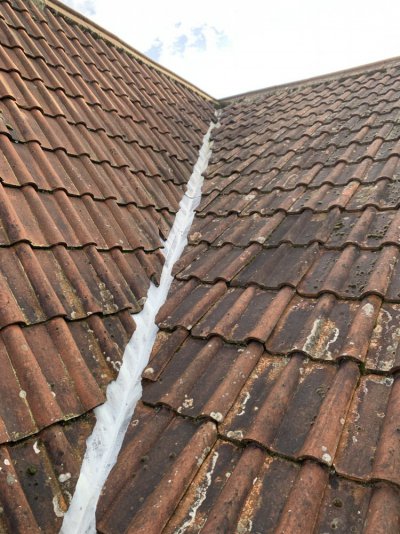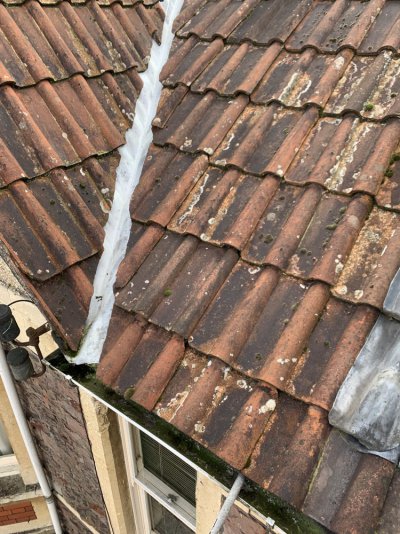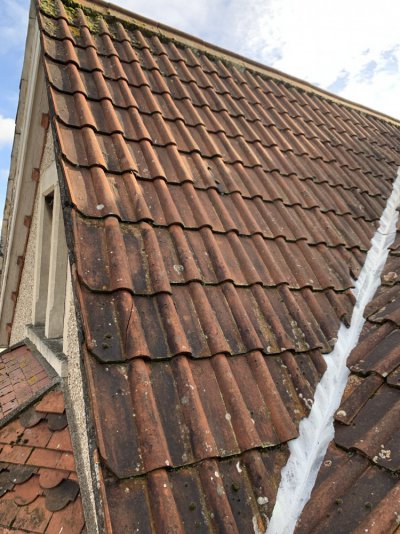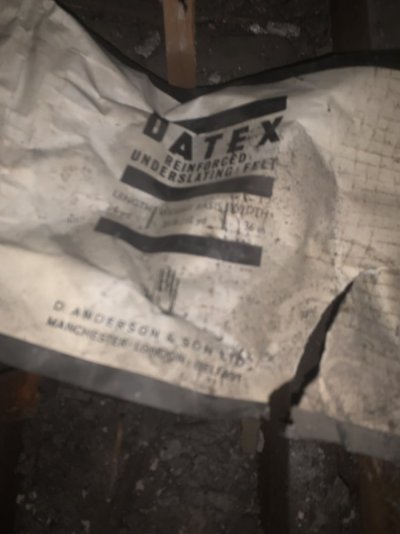Hi, I'm new to the forum...thanks in advance for any feedback and advice.
We recently bought a 1903 non-listed 3-story victorian house in the Bristol area. We knew when we bought that the soffits and fascias needed TLC, but the roof looked fine for a while (has had a few fixes over the years). It's got clay double romans with a bitumen underlay, and I'm guessing this was laid around 1950-1960, based on the underlay packaging we found and the many old slate tiles in the voids (we assume it was welsh slate initially, but most people on the street have cement). On exposing the voids internally to prepare to insulate the top rooms, the lower areas of the roof have felt that getting brittle and some holes. We also found some areas of rot which can be fixed from inside if needed (the roof is mostly dry), and condensation is present on the felt in the top of the roof void.
I've had a couple of roofers over for advice. Two of these recommended new tiles with breathable membrane, however another who appears to work on more period properties, suggested we'd be mad to lose the old clay tiles, and that breathable membrane is not right for double romans. He even suggested we replace an area that has had breathable membrane used to non-breathable. He would use F1 bitumen underlay (like we have) if we wanted the roof relayed, however he was suggesting it wasn't an absolute need to relay now...unlike the others. As others have suggested here on posts I've read, the cost of the scaffold to fix soffits and gutters may make it worth insulating from the outside, relaying the roof and I'd get a 15 year insurance guarantee. I like this alternative approach, however I cannot seem to find much to back up the use of non-breathable membranes. His explanation is that double romans are designed to be breathable themselves and allow ventilation, and then vents are added to ventilate the internal side of the felt.
I've attached some photos. It's worth noting that I'm probably sharing the poorest tiles here, as they are in a shaded north west facing front. the ones at the back appear to be much better
Hope to get some advice. Thanks

![IMG_9469[65].jpg IMG_9469[65].jpg](https://www.periodproperty.co.uk/forum/data/attachments/6/6212-c7fd44804e8f369ac15078ff4a4a3772.jpg?hash=x_1EgE6PNp)
![IMG_9465[54].jpg IMG_9465[54].jpg](https://www.periodproperty.co.uk/forum/data/attachments/6/6213-e1d551c91d24ac70b832044d82c38739.jpg?hash=4dVRyR0krH)



We recently bought a 1903 non-listed 3-story victorian house in the Bristol area. We knew when we bought that the soffits and fascias needed TLC, but the roof looked fine for a while (has had a few fixes over the years). It's got clay double romans with a bitumen underlay, and I'm guessing this was laid around 1950-1960, based on the underlay packaging we found and the many old slate tiles in the voids (we assume it was welsh slate initially, but most people on the street have cement). On exposing the voids internally to prepare to insulate the top rooms, the lower areas of the roof have felt that getting brittle and some holes. We also found some areas of rot which can be fixed from inside if needed (the roof is mostly dry), and condensation is present on the felt in the top of the roof void.
I've had a couple of roofers over for advice. Two of these recommended new tiles with breathable membrane, however another who appears to work on more period properties, suggested we'd be mad to lose the old clay tiles, and that breathable membrane is not right for double romans. He even suggested we replace an area that has had breathable membrane used to non-breathable. He would use F1 bitumen underlay (like we have) if we wanted the roof relayed, however he was suggesting it wasn't an absolute need to relay now...unlike the others. As others have suggested here on posts I've read, the cost of the scaffold to fix soffits and gutters may make it worth insulating from the outside, relaying the roof and I'd get a 15 year insurance guarantee. I like this alternative approach, however I cannot seem to find much to back up the use of non-breathable membranes. His explanation is that double romans are designed to be breathable themselves and allow ventilation, and then vents are added to ventilate the internal side of the felt.
I've attached some photos. It's worth noting that I'm probably sharing the poorest tiles here, as they are in a shaded north west facing front. the ones at the back appear to be much better
Hope to get some advice. Thanks

![IMG_9469[65].jpg IMG_9469[65].jpg](https://www.periodproperty.co.uk/forum/data/attachments/6/6212-c7fd44804e8f369ac15078ff4a4a3772.jpg?hash=x_1EgE6PNp)
![IMG_9465[54].jpg IMG_9465[54].jpg](https://www.periodproperty.co.uk/forum/data/attachments/6/6213-e1d551c91d24ac70b832044d82c38739.jpg?hash=4dVRyR0krH)



